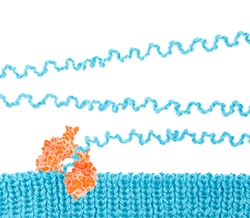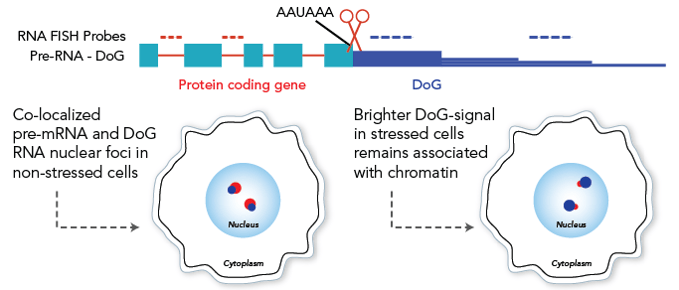Originally published : Thu, September 17, 2015 @ 5:28 PM
 Updated : Tue, March 21, 2023 @ 3:53 PM
Updated : Tue, March 21, 2023 @ 3:53 PM
The cleavage and polyadenylation event, the final trimming in the molecular mRNA barbershop, normally releases both the finished styled mRNA, and the stylist. But, in salt-stressed cells, as there are fewer transcription starts, the polymerase stays busy, and keeps on going, and going, down the template strand as if there were no end in sight. Then, as the cell has finished acclimatizing to the new environment, and as promoter-guided gene transcription starts up again, the previously unwanted RNA growth can now serve as a guide for the barber to find a chair with a new customer in need of styling. RNA-style. Cap first, then splice, and lastly, trim the ends.
Anna Vilborg and colleagues in the laboratory of Nobel prize winning Joan Steitz, authored a well-supported paper in Molecular Cell1, detailing their discovery and characterization of thousands of RNA transcripts generated by read-through downstream of protein coding genes (DoGs). They also clarify how their production is regulated by signaling through the inositol-3-phosphate receptor 1 (IP3R1) and subsequent intracellular Ca2+ release.
To obtain a key piece of evidence in validating that the DoGs indeed are the products of read-through and not generated by transcription from their own promoters, Vilborg et al. utilized duplex Stellaris® RNA FISH to localize the DoGs and the upstream pre-mRNA introns. Co-localization of signals from the two probe sets (labeled with different fluorophores) to the same distinct nuclear foci at their sites of transcription also means that the DoGs remain associated with the chromatin, where the authors hypothesize that they may contribute to maintaining the nuclear architecture of the osmotically stressed cell. The use of multiplex Stellaris RNA FISH for introns and exons of both mRNA and lncRNA coding genes to determine the cytoplasmic and nuclear localization at or away from the sites of synthesis was also presented recently by LGC Biosearch Technologies’ R&D scientists2. This study is an excellent example of how visualizing single RNA molecules is opening a whole new area of exploration and expands our understanding of gene transcription.
RNA in Non-stressed Cells and Stressed Cells

References
- Widespread inducible transcription downstream of human genes. Vilborg, A; Passarelli, MC; Yario, TA; Tycowski, KT; Steitz, JA. Mol. Cell. 2015 Aug 5. 59(3): 449-61. doi: 10.1016/j.molcel.2015.06.016.
- Duplex imaging of pre-lncRNAs and mature lncRNAs by Stellaris® RNA fluorescence in situ hybridization (RNA FISH). Orjalo, Jr., AV; Johansson, HE. Keystone Symposium on Long Noncoding RNAs: From Evolution to Function. March 15-20, 2015. Keystone, CO.

